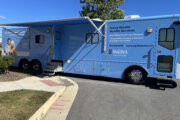For nine months, Elizabeth Christy did nothing but sit in her recliner. At least that’s the way she remembers it. “I was exhausted the whole time — I couldn’t work,” says the 33-year-old IT analyst of her second pregnancy. “All I wanted to do was sleep and eat.”
The childbirth itself was no easier. After 20 hours of labor, Christy’s muscles gave out. “I couldn’t push anymore,” she recalls. Doctors used forceps to slide her broad-shouldered daughter the rest of the way out. After the birth in February, “I was in severe pain,” says Christy, whose OB-GYN discharged her with extra pain medications.
While fatigue is a common symptom of pregnancy, laboring for 20 hours would deplete anyone and recovering from childbirth doesn’t exactly feel good, Christy’s experience was amplified. Diagnosed with fibromyalgia in 2010, Christy already deals with chronic pain, exhaustion and mental fog on a regular basis.
Whether to have a second child on top of that “was a really hard decision,” says Christy, author of the children’s book, “Why Does Mommy Hurt?: Helping Children Cope with the Challenges of Having a Caregiver with Chronic Pain, Fibromyalgia, or Autoimmune Disease.” While she wanted another baby, she feared enduring more pain, which had only magnified since the birth of her first child. “I just decided to do it no matter what happened.”
For Better or Worse
Fibromyalgia affects about 2 percent of the population and is about seven times more common in women than men, according to the Centers for Disease Control and Prevention. The condition, characterized by widespread pain, fatigue, and sleep and memory problems, is believed to be rooted in the central nervous system — not the aching body part or parts themselves, says Dr. Daniel Clauw, a professor of anesthesiology, rheumatology and psychiatry at the University of Michigan, where he directs Michigan’s Chronic Pain and Fatigue Research Center.
People with fibromyalgia, he explains, seem to have a more sensitive setting on their pain processing system than people without the condition. “Thus, they feel more things in their body as painful that other people [who] have a lower volume-control setting would not feel as pain,” he says. A paper cut could feel like a deeper slash; a walk might leave legs as heavy as post-marathon; a twisted ankle could feel broken.
It follows, then, that pregnancy with fibromyalgia would be miserable. Indeed, while there’s no major research on the topic, one pilot study presented in 2005 suggests that pregnant women with the condition experience more pain, fatigue and psychological stress than those without fibromyalgia. For Christy, “fibro fog” — which typically manifests as language errors, like saying “plate” when she means “cup,” for example — was also more frequent during pregnancy.
What’s more, medications used to treat fibromyalgia haven’t shown to be safe during pregnancy, yet non-pharmacological coping mechanisms — such as exercise and stress reduction — can be tough for any pregnant woman to employ.
“Pregnancy does put musculoskeletal strain on the body, it does disrupt sleep and it does make people stop their regular exercise routines” — all changes that could make fibromyalgia worse, Clauw says. But that’s not always the case.
“[Women] do better than they think they’ll do, and they do better than I think they’ll do,” Clauw says.
In fact, some women might find their fibromyalgia symptoms actually improve during pregnancy, says Dr. Howard Sharp, an OB-GYN at the University of Utah Health Sciences Center, where he heads the Pelvic Pain Clinic. “The immune system kind of goes on holiday during pregnancy, which is beneficial to patients.”
That was the case for Christy when she was pregnant with her first child. Her symptoms improved so much she thought she “was cured,” she remembers. But after she stopped breast-feeding, her fibromyalgia symptoms — namely, joint pain in her feet — came back in full force. “It was a daily struggle,” she says.
While no one’s studied it, Clauw speculates the oxytocin released during pregnancy, childbirth and breast-feeding helps ease fibromyalgia pain. “It’s at least theoretically possible that some of the hormonal changes that occur during pregnancy make pain better,” he says.
It can also make new motherhood better, he’s found. “[New moms] are not sleeping at all, they’re waking up every two hours, they’re not exercising at all, it’s stressful to be new mother,” he says. “That was where I was particularly surprised that a lot of people were doing better than they had before they had become pregnant.”
How to Cope
One of the first things Sharp tells patients with fibromyalgia who are pregnant or are considering becoming pregnant is that their condition — which the pilot study found can sometimes be dismissed as simply pregnancy symptoms — is real.
“Patients need reassurance that fibromyalgia is a real disease, because for a long time, it has kind of been questioned,” he says. But now, studies show that people with fibromyalgia have higher levels of the brain molecules that signal pain and lower levels of molecules that help ease it. “We’re seeing a reason why people who have fibromyalgia actually have a problem with their kind of own analgesic system,” Sharp says. “The light bulb is coming on.”
Here’s what else he and other experts tell moms-to-be with fibromyalgia:
1. Understand the risks.
While it’s safe to become pregnant and have a baby if you have fibromyalgia, some research suggests the condition can raise the risk of miscarriage, intrauterine growth restriction and diabetes, Sharp says.
Staying on fibromyalgia medications — usually antidepressants that make the hormone norepinephrine more available, or drugs that seem to block nerve-pain signals — during pregnancy might be risky to the developing baby, some animal studies suggest. On the other hand, there hasn’t been enough strong research to show how they affect human babies, and going off medication poses its own set of risks. Bottom line? Talk to your doctor about the pros and cons. “It’s usually one of those balancing acts,” Sharp says.
Christy, for one, decided with her doctors to stay on some of her medications for her second pregnancy. “That made me feel a lot more comfortable with going through the pregnancy,” she says.
2. Get moving.
It may seem counterintuitive to tell people with widespread muscle pain to exercise, but it works, Sharp says. Sedentary behavior can lead to muscle atrophy, which only makes pain worse, he says. “The more we understand how muscle fibers work, it’s important to get blood and oxygen to them,” he says.
Sharp recommends 30 minutes of low-impact exercise — such as walking, using the elliptical or a stationary bike, or aquatic exercise — a day. Yoga can be very helpful, too, says Dr. May Chin, an anesthesiologist and pain medicine specialist at the George Washington University Hospital in the District of Columbia.
But don’t overdo it. If the pain gets above a 3 on a scale of 1 to 10, you’re probably pushing too hard, Sharp says. “I try to emphasize stretch rather than strengthen.”
3. Pace yourself.
Too often, women try to squeeze in all their tasks — shopping, gardening, cooking — on days when they feel less pain, Sharp says. But “the next day, they’re in a deep hole.”
“If you’re having a good day, pace yourself because you will end up paying for it,” he says. That’s particularly true during pregnancy, since you’re carrying more weight and have more blood volume — all of which is taxing on the body, Sharp says.
4. Embrace lifestyle interventions.
Christy swears by her “large body pillow” that she used to help her sleep during pregnancy — and still uses today. “Otherwise, I wouldn’t have been able to sleep at all,” she says. That wouldn’t be good, since sleep helps “replenish the neurotransmitters in our central nervous system,” Sharp says.
Other lifestyle changes can also help. For Christy, that meant a healthy diet, a heating pad and sneakers rather than dressy shoes. She now meditates and enjoys warm baths with Epsom salts — in addition to taking medications, including tramadol and Celebrex — to cope with the pain.
“The single most helpful thing” for patients with fibromyalgia during pregnancy is physical therapy, since pregnancy hormones can make joints less stable — adding insult to injury, Sharp says. “Getting them back in alignment and moving is important,” he says. Visiting a chiropractor also helped Christy cope with hip and lower back pain during both pregnancies.
Pregnant or not, cognitive behavior therapy is a first-line defense against symptoms of fibromyalgia, Chin says. The therapy can improve sleep and depressive symptoms, and reduce stress — without drugs. Stressing less is important, Sharp says, “because when you sense stress, your neuropeptides are elevated, and this can make the pain transmission worse.”
6. Consider an epidural.
Most patients with fibromyalgia, Christy included, opt for an epidural during labor, Sharp says. “If they’re having a difficult time coping with pain, I think an epidural is a very safe option,” he says. If women want to labor without one, interventions such as a birthing ball or warm bath can help, he adds.
7. Seek support.Asking for help with, say, cooking or child care, both during and after pregnancy, is key. “You will need it,” says Christy, who relied on her mom to bring over many meals and continues to call on her husband to pick up the baby. Hiring a nanny or a postpartum doula for the first few months of motherhood is worth considering, too, she says.
Not all support has to be in-person. For Christy, online support groups for moms with fibromyalgia and chronic pain helped her not feel so alone. “The most important thing that anyone can do is to join a support group or talk to other people who have the condition,” she says. “When you talk to other women with the condition, it’s not only therapeutic, but it also gives you tons of advice and knowledge.”
More from U.S. News
10 Things No One Tells You About Breast-feeding
10 Ways to Make Your Childbirth Easier
11 Ways to Cope With Back Pain
Coping With Fibromyalgia During Pregnancy originally appeared on usnews.com







